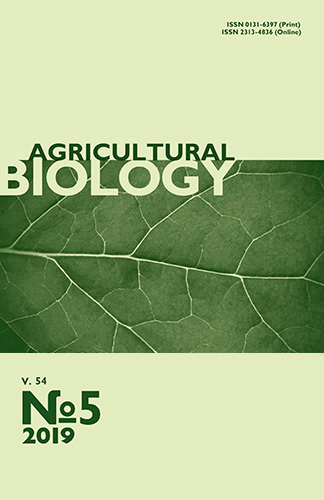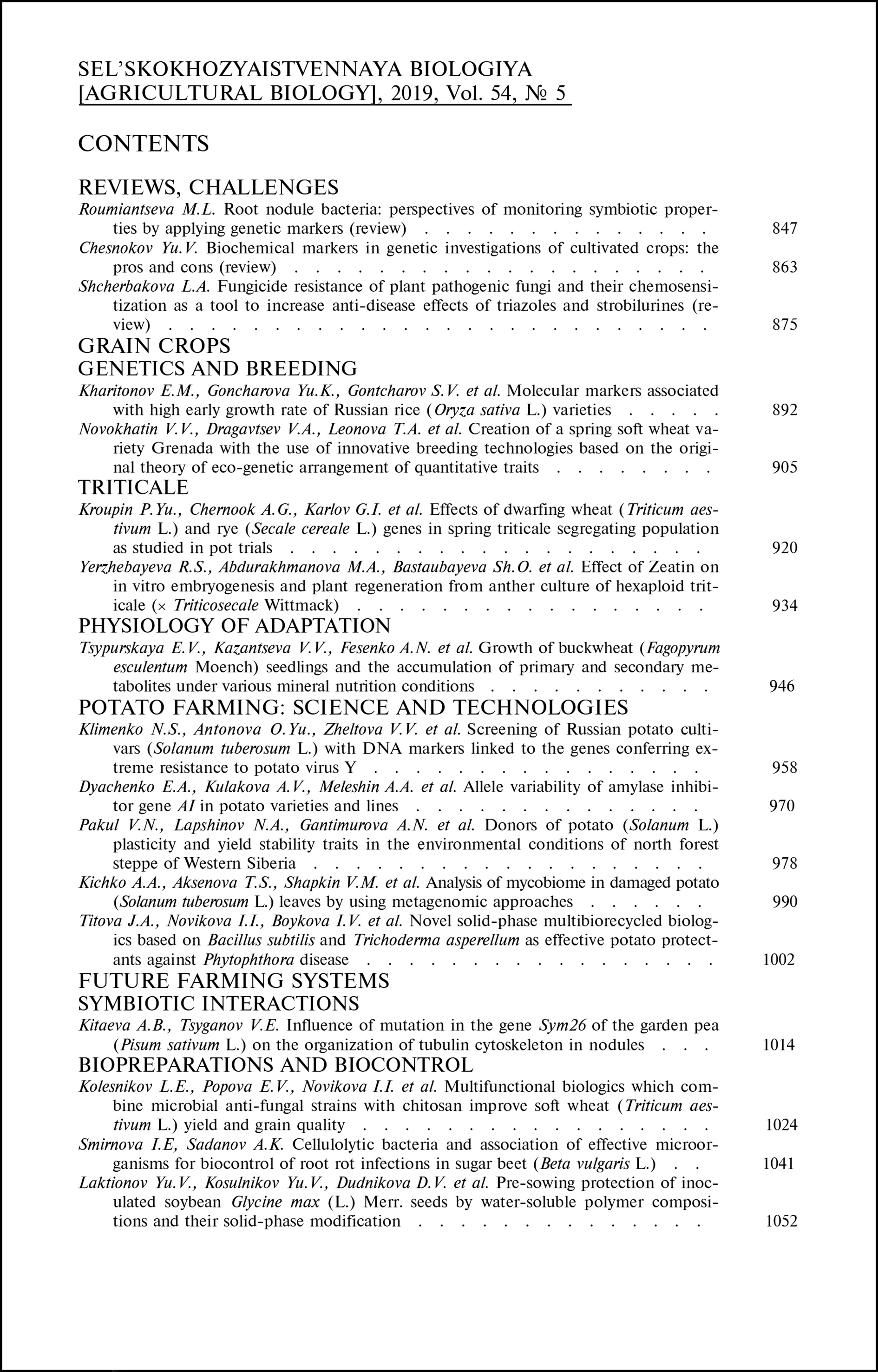doi: 10.15389/agrobiology.2019.5.1014eng
UDC: 635.656:631.461.52:576
Acknowledgements:
The work was carried out on the equipment of the ARRIAM Center for Genomic Technologies, Proteomics and Cell Biology and of the BIN RAS Center for Cell and Molecular Technologies of Studying Plants and Fungi.
Supported financially by Russian Science Foundation (grant № 16-16-10035)
INFLUENCE OF MUTATION IN THE GENE Sym26 OF THE GARDEN PEA (Pisum sativum L.) ON THE ORGANIZATION OF TUBULIN CYTOSKELETON IN NODULES
A.B. Kitaeva, V.E. Tsyganov
All-Russian Research Institute for Agricultural Microbiology, 3, sh. Podbel’skogo, St. Petersburg, 196608 Russia, e-mail anykitaeva@gmail.com, tsyganov@arriam.spb.ru (✉ corresponding author)
ORCID:
Kitaeva A.B. orcid.org/0000-0001-7873-6737
Tsyganov V.E. orcid.org/0000-0003-3105-8689
Received February 11, 2019
Symbiotic nodule is a unique organ forming on legume roots. Indeterminate nodules (with prolonged meristem activity) (F. Guinel, 2009) are characterized by differentiation of both the nodule cells and the bacteria that infect nodule and are converted into a form specialized for nitrogen fixation — bacteroids. Bacteroids surrounded by a membrane of plant origin, form organelle-like symbiosomes (A. Tsyganova et al., 2018; T. Coba de la Peña et al., 2018). Cell differentiation leads to appearance of uninfected (free of bacteria) and infected cells filled with many thousands of symbiosomes formed in the central part of nodule (A. Tsyganova et al., 2018). A prolonged activity of the meristem results in histological zonation of the indeterminate nodule. A meristem, an infection zone, a nitrogen fixation zone are distinguished, and a senescence zone appears in the basal part of a mature nodule (F. Guinel, 2009). Obviously, the tubulin cytoskeleton plays an important role in the development of a nodule, but until now researchers had a focus on the early stages of nodule development (A. Timmers, 2008). Only recently it was revealed that the tubulin cytoskeleton plays a key role in the differentiation of nodule cells (A. Kitaeva et al., 2016). It was shown that in nodules of garden pea (Pisum sativum L.) and barrel medic (Medicago truncatula Gaertn.) the release of bacteria into the cytoplasm of a plant cell prevents the formation of a regular pattern of cortical microtubules, oriented parallel to each other and perpendicular to the longitudinal axis of the cell, typical for uninfected cells. This leads to an irregular pattern of cortical microtubules, the appearance of which contributes to the transition of infected cells to isodiametric growth (A. Kitaera et al., 2016). Endoplasmic microtubules build a mold for the growth of infection threads, and support the location of infection droplets and symbiosomes in infected cells (A. Kitaeva et al., 2016). However, changes in the organization of the tubulin cytoskeleton during senescence of nodule cells have not been studied. In this study, using immunocytochemical analysis and confocal laser scanning microscopy, the organization of the tubulin cytoskeleton in the nodules of the pea mutant SGEFix--3 (sym26) (V. Tsyganov et al., 2000) was studied. This mutant is characterized by the formation of ineffective nodules with premature degradation of symbiotic structures (T. Serova et al., 2018). It was shown that in the mutant line, the formed patterns of cortical and endoplasmic microtubules did not differ from those of the initial line SGE. Cortical microtubules formed an irregular pattern in meristematic and infected cells and regular pattern in uninfected and colonized cells. Endoplasmic microtubules surrounded the nucleus in interphase cells, formed spindles and preprophase bands during mitosis, and also surrounded infection threads. At the same time, in the senescence zone in degrading cells, complete depolymerization of the tubulin cytoskeleton occurred in both infected and uninfected cells. In the initial line, senescence was induced only in four-week-old nodules, and microtubule depolymerization was also observed in senescent cells. Thus, the complete depolymerization of microtubules in various types of nodule cells can be a cytological marker of its senescence.
Keywords: legume-rhizobial symbiosis, microtubules, symbiosome, bacteroid, infection thread, nodule senescence, immunolocalization, Pisum sativum.
REFERENCES
- Oldroyd G.E. Speak, friend, and enter: signalling systems that promote beneficial symbiotic associations in plants. Nature Reviews Microbiology, 2013, 11: 252-263 CrossRef
- Guinel F.C. Getting around the legume nodule: I. The structure of the peripheral zone in four nodule types. Botany, 2009, 87: 1117-1138 CrossRef
- Brewin N.J. Development of the legume root nodule. Annual Review of Cell Biology, 1991, 7: 191-226 CrossRef
- Serova T.A., Tsyganov V.E. Symbiotic nodule senescence in legumes: molecular-genetic and cellular aspects (review). Agricultural Biology [Sel'skokhozyaistvennaya biologiya], 2014: 3-15 CrossRef
- Tsyganova A.V., Kitaeva A.B., Tsyganov V.E. Cell differentiation in nitrogen-fixing nodules hosting symbiosomes. Functional Plant Biology, 2018, 45: 47-57 CrossRef
- Coba de la Peña T., Fedorova E., Pueyo J.J., Lucas M.M. The symbiosome: legume and rhizobia co-evolution toward a nitrogen-fixing organelle? Frontiers in Plant Science, 2018, 8: 2229 CrossRef
- Timmers A.C.J. The role of the plant cytoskeleton in the interaction between legumes and rhizobia. Journal of Microscopy, 2008, 231: 247-256 CrossRef
- Cárdenas L., Vidali L., Domınguez J., Pérez H., Sánchez F., Hepler P.K., Quinto C. Rearrangement of actin microfilaments in plant root hairs responding to Rhizobium etli nodulation signals. Plant Physiology,1998, 116: 871-877 CrossRef
- Miller D.D., De Ruijter N.C., Bisseling T. The role of actin in root hair morphogenesis: studies with lipochito-oligosaccharide as a growth stimulator and cytochalasin as an actin perturbing drug. The Plant Journal, 1999, 17: 141-154 CrossRef
- Yokota K., Fukai E., Madsen L.H., Jurkiewicz A., Rueda P., Radutoiu S., Held M., Hossain M.S., Szczyglowski K., Morieri G. Rearrangement of actin cytoskeleton mediates invasion of Lotus japonicus roots by Mesorhizobium loti. The Plant Cell, 2009, 21: 267-284 CrossRef
- Miyahara A., Richens J., Starker C., Morieri G., Smith L., Long S., Downie J.A., Oldroyd G.E.D. Conservation in function of a SCAR/WAVE component during infection thread and root hair growth in Medicago truncatula. Molecular Plant-Microbe Interactions, 2010, 23: 1553-1562 CrossRef
- Hossain M.S., Liao J., James E.K., Sato S., Tabata S., Jurkiewicz A., Madsen L.H., Stougaard J., Ross L., Szczyglowski K. Lotus japonicus ARPC1 is required for rhizobial infection. Plant Physiology, 2012, 160: 917-928 CrossRef
- Qiu L., Lin J.-s., Xu J., Sato S., Parniske M., Wang T.L., Downie J.A., Xie F. SCARN a novel class of SCAR protein that is required for root-hair infection during legume nodulation. PLOS Genetics, 2015, 11: e1005623 CrossRef
- Zhang X., Han L., Wang Q., Zhang C., Yu Y., Tian J., Kong Z. The host actin cytoskeleton channels rhizobia release and facilitates symbiosome accommodation during nodulation in Medicago truncatula. New Phytologist, 2019, 221(2): 1049-1059 CrossRef
- Ridge R.W., Rolfe B.G. Rhizobium sp. degradation of legume root hair cell wall at the site of infection thread origin. Applied and Environmental Microbiology, 1985, 50: 717-720.
- Turgeon B.G., Bauer W.D. Ultrastructure of infection thread development during infection of soybean by Rhizobium japonicum. Planta, 1985, 163: 328-349 CrossRef
- Timmers A.C., Auriac M.C., Truchet G. Refined analysis of early symbiotic steps of the Rhizobium-Medicago interaction in relationship with microtubular cytoskeleton rearrangements. Development, 1999, 126: 3617-3628.
- Weerasinghe R.R., Collings D.A., Johannes E., Allen N.S. The distributional changes and role of microtubules in Nod factor challenged Medigaco sativa root hairs. Planta, 2003, 218: 276-289 CrossRef
- Sieberer B.J., Timmers A.C., Emons A.M.C. Nod factors alter the microtubule cytoskeleton in Medicago truncatula root hairs to allow root hair reorientation. Molecular Plant-Microbe Interactions, 2005, 18: 1195-1204 CrossRef
- Vassileva V.N., Kouchi H., Ridge R.W. Microtubule dynamics in living root hairs: transient slowing by lipochitin oligosaccharide nodulation signals. The Plant Cell, 2005, 17: 1777-1787 CrossRef
- Timmers A.C., Vallotton P., Heym C., Menzel D. Microtubule dynamics in root hairs of Medicago truncatula. European Journal of Cell Biology, 2007, 86: 69-83 CrossRef
- Perrine-Walker F.M., Lartaud M., Kouchi H., Ridge R.W. Microtubule array formation during root hair infection thread initiation and elongation in the Mesorhizobium-Lotus symbiosis. Protoplasma, 2014, 251: 1099-1111 CrossRef
- Timmers A.C., Auriac M.C., de Billy F., Truchet G. Nod factor internalization and microtubular cytoskeleton changes occur concomitantly during nodule differentiation in alfalfa. Development, 1998, 125: 339-349.
- Whitehead L.F., Day D.A., Hardham A.R. Cytoskeletal arrays in the cells of soybean root nodules: The role of actin microfilaments in the organisation of symbiosomes. Protoplasma, 1998, 203: 194-205 CrossRef
- Davidson A.L., Newcomb W. Organization of microtubules in developing pea root nodule cells. Canadian Journal of Botany, 2001, 79: 777-786 CrossRef
- Fedorova E.E., de Felipe M.R., Pueyo J.J., Lucas M.M. Conformation of cytoskeletal elements during the division of infected Lupinus albus L. nodule cells. Journal of Experimental Botany, 2007, 58: 2225-2236 CrossRef
- Kitaeva A.B., Demchenko K.N., Tikhonovich I.A., Timmers A.C.J., Tsyganov V.E. Comparative analysis of the tubulin cytoskeleton organization in nodules of Medicago truncatula and Pisum sativum: bacterial release and bacteroid positioning correlate with characteristic microtubule rearrangements. New Phytologist, 2016, 210: 168-183 CrossRef
- Hogetsu T., Oshima Y. Immunofluorescence microscopy of microtubule arrangement in root cells of Pisum sativum L. var Alaska. Plant and Cell Physiology, 1986, 27: 939-945 CrossRef
- Adamakis I.D.S., Panteris E., Eleftheriou E.P. Tungsten affects the cortical microtubules of Pisum sativum root cells: experiments on tungsten-molybdenum antagonism. Plant Biology, 2010, 12: 114-124 CrossRef
- Kosterin O.E., Rozov S.M. Mapping of the new mutation blb and the problem of integrity of linkage group I. Pisum Genetics, 1993, 27-31.
- Tsyganov V.E., Voroshilova V.A., Borisov A.Y., Tikhonovich I.A., Rozov S.M. Four more symbiotic mutants obtained using EMS mutagenesis of line SGE. Pisum Genetics, 2000, 32: 63.
- Serova T.A., Tsyganova A.V., Tsyganov V.E. Early nodule senescence is activated in symbiotic mutants of pea (Pisum sativum L.) forming ineffective nodules blocked at different nodule developmental stages. Protoplasma, 2018, 255: 1443-1459 CrossRef
- Wang T.L., Wood E.A., Brewin N.J. Growth regulators, Rhizobium and nodulation in peas. Planta, 1982, 155: 345-349 CrossRef
- Fåhraeus G. The infection of clover root hairs by nodule bacteria studied by a simple glass slide technique. Microbiology, 1957, 16: 374-381 CrossRef
- Tsyganov V.E., Morzhina E.V., Stefanov S.Y., Borisov A.Y., Lebsky V.K., Tikhonovich I.A. The pea (Pisum sativum L.) genes sym33 and sym40 control infection thread formation and root nodule function. Molecular and General Genetics, 1998, 259: 491-503.
- Borisov A.Y., Rozov S., Tsyganov V., Kulikova O., Kolycheva A., Yakobi L., Ovtsyna A., Tikhonovich I. Identification of symbiotic genes in pea (Pisum sativum L.) by means of experimental mutagenesis. Genetika (Russian Federation), 1994, 30: 1484-1494.
- Wang D., Griffitts J., Starker C., Fedorova E., Limpens E., Ivanov S., Bisseling T., Long S. A nodule-specific protein secretory pathway required for nitrogen-fixing symbiosis. Science, 2010, 327: 1126-1129 CrossRef
- Gavrin A., Jansen V., Ivanov S., Bisseling T., Fedorova E. ARP2/3-mediated actin nucleation associated with symbiosome membrane is essential for the development of symbiosomes in infected cells of Medicago truncatula root nodules. Molecular Plant-Microbe Interactions, 2015, 28: 605-614 CrossRef












